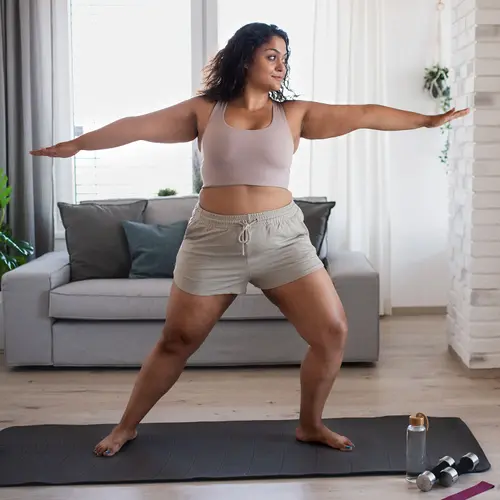Social media feeds filled with photos of fitness models twisted into poses requiring extreme strength, flexibility, and balance may leave you thinking, “Yoga is not for me.”
Nadine Kelly, MD, founder of Yogi MD, wants to change your mind.
“We tend to think of yoga as an athletic endeavor that has to be done on a mat,” Kelly says. “Yoga practice is about much more than the physical [poses]; the practice includes skills like breathing, regulating your emotions, and practicing self-care.”
What Is Chair Yoga?
Chair yoga, a gentle form of yoga that’s done while seated or using a chair for balance, makes the practice more accessible. In chair yoga, it’s possible to move into poses like cat/cow, warrior, sun salutations and forward folds, all while seated.
Kelly believes the Arthur Ashe quote, “Start where you are, use what you have, do what you can,” is perfect for chair yoga.
“You’re there to work and to challenge yourself, but it’s about … knowing what’s right for you,” she says. “I think of yoga poses as adaptable to a student’s body and not the other way around.”
Whether yoga is done in a chair or on the mat, the practice still focuses on the same core principles: focusing on your breath, paying attention to your thoughts, and staying in the moment.
The Benefits of Chair Yoga
Research shows yoga is linked to decreased levels of stress, anxiety, and depression, lowered cholesterol and blood pressure, improved energy, better sleep quality, less pain, and reduced body mass index. Matt Minard PT, DPT, physical therapist with Atrium Health in Charlotte, NC, believes those benefits extend to chair yoga.
Chair yoga is also a good, safe workout for beginners.
“It’s a great way to work your core, explore the different range of motion of the joints and prioritize movement,” Minard says. “When you’re sitting down or using a chair for balance, the safety factor goes way up.”
Who Should Try Chair Yoga?
Although chair yoga is often promoted as a practice for those who may struggle with a mat practice, anyone can benefit from this type of gentle exercise.
Kelly says chair yoga is particularly well-suited to people who use wheelchairs and those rehabilitating after surgeries, living with chronic illnesses, or dealing with balance issues that make it hard to get down onto a yoga mat. It’s also perfect for a quick workout during the workday or while traveling.
“It’s not about the outcome. It’s not about striking the perfect pose,” Kelly says. “Whether yoga is taught on the mat or in a chair, it’s all about being healthy.”
Chair yoga is also ideal for beginners who might be intimidated by a traditional mat practice because it offers a safe way to learn the poses, Minard adds.
Where to Find Chair Yoga Classes
You can find chair yoga classes at community centers, fitness facilities, and yoga studios. There are also a lot of online options. In this video, Kelly provides detailed instructions for a short chair yoga practice that is suitable for all levels.
How to Get Started
To practice at home, use a sturdy chair (an office chair on wheels or overstuffed armchair are not appropriate for chair yoga). Minard suggests a chair that naturally positions your hips slightly higher than your knees and allows you to put both feet flat on the floor.
“If your feet aren’t flat on the ground, your weight is all in your spine and if the chair is too low and your knees are above your hips, there is more impingement on your hips,” Minard says. “You want to be able to do slow, controlled movements without putting extra stress on your back or hips.”
Make sure the chair is on a stable surface like carpet or a yoga mat to keep it from slipping. You can also position the back of the chair against a wall for extra stability, Minard adds.
Yoga props like blocks, straps, and resistance bands that are common in mat practices aren’t required for chair yoga -- unless you want an extra challenge.
“Chair yoga is a good starting point to use muscles you haven’t used in a while without the potential risks of overloading [your muscles and joints] or falling,” Minard says. “If the resistance from your body weight isn’t enough of a challenge, you can add light hand weights, ankle weights or resistance bands to your chair yoga practice.”


